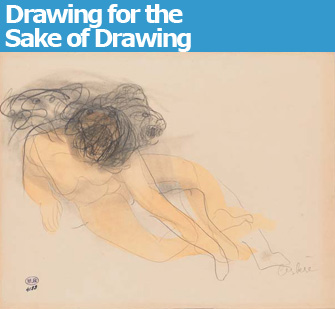 |
|
Auguste Rodin’s “Cerbère.” © Musée Rodin. Photo: Jean de Calan |
Who knew that sculptors were such fanatics about drawing? Two exhibitions in Paris reveal this little-known side of Auguste Rodin (1840-1917) and Antoine …
 |
|
Auguste Rodin’s “Cerbère.” © Musée Rodin. Photo: Jean de Calan |
Who knew that sculptors were such fanatics about drawing? Two exhibitions in Paris reveal this little-known side of Auguste Rodin (1840-1917) and Antoine Bourdelle (1861-1929).
“La Saisie du Modèle” (“Capturing the Model”) at the Musée Rodin is a must-see. I love Rodin’s drawings, which he did regularly for the sake of drawing itself, not just as studies for his sculptures, bringing a model into his studio every day between 1890 and 1917, the year he died. Exploding with energy and spontaneity, they depict the models in every conceivable (and some inconceivable; they must have been painful for the poor model) position, many of them erotic.
In this show, which offers a representative sampling from the museum’s holdings of over four thousand of these drawings, we see Rodin experimenting furiously with line and color. In some, he uses the technique of instantaneous drawing: looking only at the model, not the paper, without lifting the pencil from the paper in an exercise to help coordinate hand and eye. Anyone who has tried this in art school with unreadable results will be amazed at the control he had.
While Rodin apparently turned up his nose at the drawings of the younger Matisse (1869-1954) when the latter showed the sculptor his portfolio (Matisse also had a studio for a time in the former convent that is now the Musée Rodin), there is definitely an affinity between the sketches of the two artists: that breathtakingly simple line that sometimes captures the model perfectly, la ligne juste, as in the Rodin drawing of a female nude reclining on her side dating from 1908. And like Matisse’s drawings, the best of Rodin’s drawings are those that are not overworked.
By the end of the show, we have seen how the artist’s quest for pure form took him to the edge of abstraction, a harbinger of what was to come in the world of art.
In the exhibition “Que du Dessin” (“Only Drawings”) at the Musée Bourdelle, we learn that Antoine Bourdelle was nearly as prolific when it came to drawing as Rodin was. And, like Rodin’s, his work ranges widely in style and subject matter and demonstrates the artist’s enthusiasm for the medium for its own sake. We even have a sprinkling of Bourdelle’s erotic drawing as well.
But, while Bourdelle’s works on paper are sometimes full of charm, they are much more finished and lack the great spontaneity of Rodin’s. Some of the drawings he did as exercises – painting from memory rather than from a model – are freer and more interesting than the more academic pieces.
Walking through this wonderful and largely neglected museum after looking at the drawings, I was struck by the fact that Bourdelle’s monumental sculptures, especially that of Heracles drawing his bow, are filled with more life, movement and tension than many of the drawings.
Note: If you want to see how one contemporary sculptor draws, visit the Richard Serra show at the Gagosian Gallery. His “drawings” (actually made with thickly applied black oil paint) are as minimalist and compelling as his sculptures.
Musée Rodin: 79, rue de Varenne, 75007 Paris. Métro: Varenne or Invalides. Tel.: 01 44 18 61 10. Open Tuesday-Sunday, 10am-5:45pm (as of January 4, open until 9pm on Wednesdays). Admission: €7. Through April 1. www.musee-rodin.fr
Musée Bourdelle: 18, rue Antoine Bourdelle, 75015 Paris. Métro: Montparnasse-Bienvenüe or Falguière. Tel: 01 49 54 73 73. Open Tuesday-Sunday, 10am-6pm. Closed Monday and public holidays. Admission: €7 (free for permanent collection). Through January 29. Web site
Reader Richard Ewan writes: “I had a similar reaction when I first saw the drawings of Henry Moore when I was an art student (I still am in many ways). I minored in sculpture in art school and yet always wanted to be a painter. I remember the ease with which I could draw what I wanted, but the difficulty I had trying to form shapes in wax. It was almost an opposite but equally satisfying experience.”
Please support Paris Update by ordering books from Paris Update’s Amazon store at no extra cost. Click on your preferred Amazon location: U.K., France, U.S.
Reader Reaction: Click here to respond to this article (your response may be published on this page and is subject to editing).
More reviews of Paris art shows.
© 2011 Paris Update
Favorite